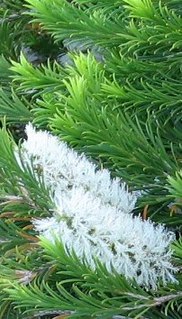
Melaleuca is a genus of nearly 300 species of plants in the myrtle family, Myrtaceae, commonly known as paperbarks, honey-myrtles or tea-trees. They range in size from small shrubs that rarely grow to more than 16 m (52 ft) high, to trees up to 35 m (115 ft). Their flowers generally occur in groups, forming a "head" or "spike" resembling a brush used for cleaning bottles, containing up to 80 individual flowers.

Melaleuca huegelii, commonly known as chenille honey-myrtle, is a plant in the myrtle family, Myrtaceae and is endemic to the south-west coastal areas of Western Australia. It has small, almost scale-like leaves and flower spikes sometimes more than 100 millimetres (4 in) long on the ends many of its branches.

Melaleuca leucadendra, commonly known as weeping paperbark, long-leaved paperbark or white paperbark is a plant in the myrtle family, Myrtaceae and is widespread in northern Australia, Southeast Asia, New Guinea and the Torres Strait Islands. It is a tree, sometimes growing to more than 20 m (70 ft) with a trunk covered with thick, white, papery bark and weeping thinner branches. It has a long flowering season, can flower at almost any time of the year and is often grown as a tree in parks and on roadsides. It was the first melaleuca to be described and was described from a specimen growing in Indonesia.

Melaleuca lanceolata commonly known as black paperbark, moonah, Rottnest Island teatree and western black tea tree is a plant in the myrtle family, Myrtaceae and is native to Australia where it occurs in Western Australia, South Australia, Victoria, New South Wales and Queensland. It is a densely foliaged tree with rough bark, which flowers prolifically in summer.

Melaleuca viminea, commonly known as mohan is a plant in the myrtle family Myrtaceae and is endemic to the south-west of Western Australia. It is variable in size and form from a densely branched, small shrub to a small tree. It has become naturalised locally in southern Victoria.

Melaleuca dissitiflora, commonly known as creek tea–tree, is a plant in the myrtle family, Myrtaceae and is native to Australia. It occurs in the drier parts of Queensland, the Northern Territory, South Australia and Western Australia. It grows in places like sandy creek beds and rocky gorges but it may have potential as a more productive source of "tea tree" oil than the usual Melaleuca alternifolia. It is closely related and very similar to Melaleuca linophylla with its papery bark, narrow leaves and loose spikes of creamy-white flowers but its flowers are larger, the stamens are longer and there are more stamens per bundle than in that species.

Melaleuca williamsii is a plant in the myrtle family, Myrtaceae and is endemic to an area between north-eastern New South Wales and south eastern Queensland in Australia. It is a distinctive shrub with stiff branches, silvery new growth, prickly leaves and spikes of purple flowers in late spring. It is classified as a vulnerable species under the Australian Government Endangered Species Protection Act.

Melaleuca acacioides, commonly known as coastal paperbark and as lunyamad by the Bardi people, is a plant in the myrtle family, Myrtaceae and is native to the northern parts of the Northern Territory, Cape York Peninsula and New Guinea. It is closely related to Melaleuca alsophila and Melaleuca citrolens, being differentiated from them by the number of flowers in a group. In this species, they are in groups of three. It is a small to medium-sized tree, sometimes with several trunks when growing in the open. It usually grows in areas with saline soils that are regularly flooded, often near mangroves.

Melaleuca dealbata, commonly known as karnbor or blue paperbark, is a plant in the myrtle family, Myrtaceae and is native to tropical areas in northern Australia, New Guinea and Indonesia. It is a medium to large leafy tree, growing in wet areas such as on the edges of coastal lagoons. It has papery bark, relatively large, blue-green leaves and spikes of cream-coloured flowers over a long period.

Melaleuca nervosa, commonly known as fibrebark, is a shrub or tree in the myrtle family Myrtaceae and is endemic to northern Australia. It is a narrow-leaved, tropical paperbark with yellow-green and red-flowering forms. As with some other melaleucas, this species has many uses to Indigenous Australians.

Melaleuca xerophila is a shrub or small tree in the myrtle family Myrtaceae and is native to arid parts of South Australia and Western Australia. It is a large shrub with narrow leaves and heads of white or cream-coloured flowers in spring.

Melaleuca biconvexa is a tree or shrub in the myrtle family, Myrtaceae and is endemic to coastal areas of New South Wales. The leaves have a distinctive, wing-like shape and the flowers are in white or cream-coloured heads at the ends of its branches. It is classified as a vulnerable species.
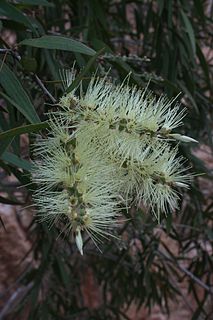
Melaleuca fluviatilis is a plant in the myrtle family, Myrtaceae and is endemic to northern Queensland in Australia. It is a tree with papery bark, narrow leaves and spikes of white or creamy-coloured flowers, usually growing along streams and rivers. It is common in tropical areas and is sometimes confused with Melaleuca argentea although it lacks that species' silvery foliage.

Melaleuca incana subsp. tenella is a plant in the myrtle family Myrtaceae which is endemic to the south coast of Western Australia. It was formerly known as Melaleuca tenella Benth. but was reduced to a subspecies in 1998. It is similar to M. incana subsp. incana except in the form of the plant, the size and shape of its leaves, its flowering time and distribution.
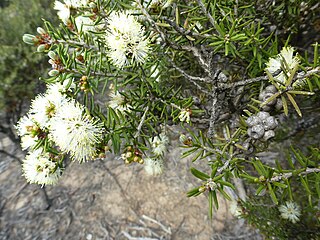
Melaleuca pauperiflora, commonly known as boree, is a plant in the myrtle family, Myrtaceae, and is native to the southern parts of South Australia and Western Australia. It is distinguished by its short, thick leaves and small but profuse heads of white or cream flowers. There are three subspecies.
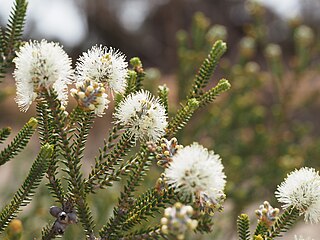
Melaleuca quadrifaria, commonly known as limestone honey-myrtle, is a plant in the myrtle family, Myrtaceae, and is native to the south of Western Australia. It is distinguished by the small size and arrangement of its leaves combined with its small spikes of white or cream flowers.

Melaleuca sieberi is a shrub or tree in the myrtle, family Myrtaceae, which is endemic to coastal areas of New South Wales and Queensland. It is a large shrub or small tree with papery bark on the trunk, small, sharp leaves and small heads of fluffy flowers in spring. It should not be confused with Callistemon sieberi. When the callistemons were moved to Melaleuca, Callistemon sieberi became Melaleuca paludicola.
Melaleuca fulgens subsp. fulgens, commonly known as the scarlet honey myrtle, is a plant in the myrtle family, Myrtaceae and is endemic to the south-west of Western Australia. In 1990, the species Melaleuca fulgens was separated into 3 subspecies and this is the most widespread of them. As with the other two subspecies, this one is notable for its showy flowers which are usually red but its foliage and fruits are also attractive features.
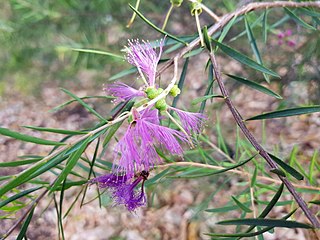
Melaleuca fulgens subsp. steedmanii, commonly known as the scarlet honey myrtle, is a plant in the myrtle family, Myrtaceae and is endemic to the south-west of Western Australia. In 1990, the species Melaleuca fulgens was separated into 3 subspecies. Of the two subspecies occurring in the south-west, this one has the narrower distribution, occurring mainly near Geraldton. As with the other subspecies, this one is notable for its showy flowers which are usually red but its foliage and fruits are also attractive features.
Melaleuca fulgens subsp. corrugata, commonly known as the wrinkled honey myrtle, is a plant in the myrtle family, Myrtaceae and is endemic to an area near the border between Western Australia, South Australia and the Northern Territory. In 1990, the species Melaleuca fulgens was separated into 3 subspecies. This subspecies has a disjunct distribution but is nevertheless very similar to the other two, only differing the colour of the flowers and small differences in the leaf shape and length of the stamens. As with the other subspecies, this one is notable for its showy flowers which are usually a shade of pink to mauve but its foliage and fruits are also attractive features.



















